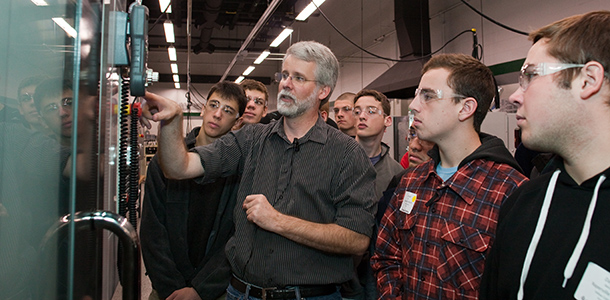
(Photo Credit: COD Newsroom/Flickr)
2017 is shaping up to be a big year for an ongoing upgrade of California's workforce. The California Community Colleges are beginning to put to work the $200 million in Career Technical Education funding the Legislature and Governor Brown approved last year.
Nearly 700 programs have been certified as part of the Strong Workforce Program to address the middle-skills gap that employers and educators are saying holds back California’s economy. Not surprisingly, many of the programs are aimed at better responding to the workforce needs in California’s largest employment sectors.
“California has the immediate need for 50,000 trained cybersecurity workers right now,” said Stephen Wright, sector navigator for Information and Communications Technology and Digital Media. “Much of the Strong Workforce funding is aimed at further strengthening the excellent IT networking programs that are underway at community colleges across California.”
The technology sector, which employs more than a million Californians, is dynamic and by its very nature requires constant training and re-training of workers. Wright pointed out the IT networking offerings at California's community colleges are the best in the country.
The large health care sector employs more than 1.6 million Californians—and the demand for a trained workforce remains high.
“Industry has been explicit in what they need — more and better medical assistants and more nurses in specialty roles,” said Linda Zorn, health care sector navigator. “With the shift in care to community and ambulatory settings, more responsibility is being shifted to the nursing profession. It's that need that this new funding and the training that comes from it is designed to address.”
The programs that have been developed are designed to be practical and responsive to help train and re-train workers and give employers what they need—a qualified pool of workers to hire.
“We have been listening to leaders from California's major employer sectors who want more and better prepared workers,” said Van Ton-Quinlivan, vice chancellor for Workforce and Economic Development. “The increased CTE funding allows to us to expand our efforts for trained middle-skills workers to meet the demand of the California regions.”
This new ongoing funding is structured with 60 percent going to “Local Share” allocations for each community college district and 40 percent to “Regional Share” allocations determined by a regional consortium of colleges that are based around the state’s seven macro-economic regions.
In each region of California, the need for manufacturing workers is critical. The industry employs 1.3 million workers in California, making it the number one manufacturing state in the country. But being number one — and staying there — depends on many factors including building and maintaining a skilled workforce.
Matt Bogoshian is the Advancing Manufacturing Action Team co-lead for the California Economic Summit, which has been promoting improved workforce development in California since its inception five years ago. Bogoshian believes this spending is a wise investment that can teach the rest of the country.
“California's Strong Workforce Program is an example of a new statewide effort to stay number one in advanced manufacturing by helping workers upgrade their skills — skills needed to make the world's best and most innovative manufactured goods,” said Bogoshian. “It is an example of the national commitment we need to have across America to arm our citizens with better skills to make things we need here in America in the 21st century.”
When legislators and the Governor approved the $200 million in funding to develop more workforce opportunity and lift low-wage workers into living-wage jobs, they took a bold step toward creating one million more middle-skill workers, a signature challenge in the California Economic Summit's Roadmap to Shared Prosperity.
“Making this investment in Career Technical Education has cemented California's leadership role in workforce development,” said Alma Salazar, senior vice president of the Center for Education Excellence & Talent Development at the Los Angeles Area Chamber of Commerce. “Now the job is to make sure these programs benefit both workers and employers and help our state and its regions prosper in our dynamic 21st century economy.”
That’s the idea behind the Strong Workforce Program.
.Click here to read the Community Colleges Economic Development and Workforce Annual Report.
To keep up with news on Strong Workforce Program and other efforts to revive upward mobility in California, sign up with the California Economic Summit.

